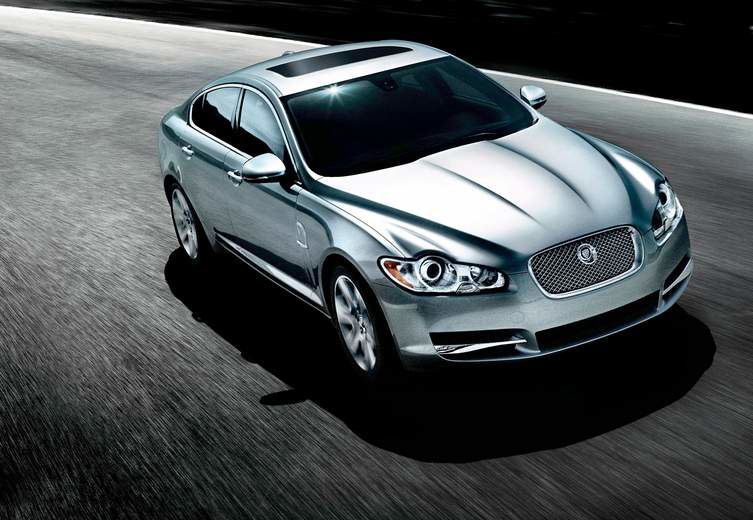A nod to practicality, devoted to sensuality
Published 5:00 am Sunday, July 5, 2009

- The 2010 Jaguar XF Premium sedan is a classically beautiful piece of motorized art, a luxury car that feints toward honoring practicality while sacrificing precious little of its aesthetic appeal.
Artifice has value, particularly in automotive journalism. I, for example, will use any excuse to get behind the wheel of a new automobile, especially one as beautiful as the 2010 Jaguar XF Premium sedan.
Visually, it differs little from the 2009 Jaguar XF Supercharged sedan I reviewed in April 2008.
It matters not.
I wouldn’t refuse a chance to drive a Jaguar XF any more than I’d turn down a front-row ticket to a Tina Turner concert. Both epitomize the difference between sex and sensuality. Sex is fleeting, often forgettable. Sensuality speaks to the heart and soul. If you’ve seen Tina once, you’ll want to see her again. If you’ve driven a Jaguar XF sedan once — the base XF, the tested XF Premium or the truly exotic XFR — you’ll want to drive one again. Any excuse that allows a repeat experience is sufficient.
I had an excuse, albeit flimsy.
Jaguar, like many of its rivals, has been under government pressure to deliver more fuel economy. But the trick for luxury brands is to do that without harming their basic character — what automotive marketers call “a car’s DNA.”
Historically, Jaguar’s DNA has yielded rear-wheel-drive automobiles known for their beauty, power and speed. But as a ward of Ford Motor, Jaguar fiddled with that formula, offering models such as the front-wheel-drive X-Type and S-Type.
The “X” and “S” were “affordable” and offered better fuel economy in comparison with traditional Jaguar standards. Stylistically, both cars were throwbacks to the days when Jaguar signaled exclusion. But neither had an ounce of traditional Jaguar panache, and both were weighted with fuel economy and performance no better than ordinary front-wheel-drive, midsize family sedans.
The novelty of the “X” and “S” wore off. Both were discontinued by the 2008 model year, when Ford, in search of cash, sold Jaguar to the Tata Group, a multinational conglomerate based in Mumbai.
With the rear-wheel-drive XF Premium, Jaguar’s designers once again are trying to please the gods of fuel economy without offending those reigning over beauty, power and speed. But it appears that the gods must be crazy.
The XF Premium comes with a new, 5-liter, 385-horsepower V-8 engine — more than enough power to satisfy motorists who want muscle, but who are not inclined to show off by flexing their motorized biceps.
It is a noble effort, one that has emerald patina. But the XF Premium yields only slightly better fuel economy than what is offered by the XFR with its supercharged, 510-horsepower version of Jaguar’s 5-liter V-8.
The XF Premium gets 16 miles per gallon in the city and 25 mpg on the highway. The XFR gets 15 mpg in the city and 23 mpg on the highway. Both models require premium unleaded gasoline.
The likelihood is that most fundamental Jaguar worshippers — the people for whom beauty, power and speed are sacred — won’t care. Such folks spend huge amounts of money and time pursuing “Jaguarness” — buying and selling Jaguar cars new and old, collecting and displaying them at regional and national car shows, getting together for “Jaguar weekends” and holding rallies crowned by festive awards dinners.
Such enthusiasts are deeply touched by details such as the contrast stitching on the XF Premium’s interior leather panels. That means some of them will be disappointed by the inconsistent use of that technique in the XF Premium, which features contrast stitching on dashboard- and door-panel coverings, but abandons the technique on the car’s leather-covered seats.
That might seem a silly concern to non-Jaguar people. But to the aficionados, it is a deficiency worthy of demerits at regional and national Jaguar car shows.
All else about the XF Premium, including its glove compartment and cup holders — elegantly hidden behind and beneath soft-touch doors of ebony wood veneer — meets show standards. The Jaguar XF Premium is one of a kind. You either love it, or you don’t.
The bottom line
Complaint: It’s a “Jaguarness” thing. A seemingly small error in such a pricey automobile — inconsistency in the use of contrast stitching in the interior — is a big deal to some of its more finicky buyers.
Ride, acceleration and handling: The XF Premium gets high marks in all three categories.
Head-turning quotient: It’s simply beautiful. It’s motorized art.
Capacities: There are seats for five people. Luggage space is 17.7 cubic feet. The fuel tank holds 18.4 gallons of required premium unleaded gasoline.
Mileage: Keep this one out of traffic jams, where it barely gets 16 mpg. Highway cruising delivers better mileage at 25 mpg.
Safety: Standard equipment includes four-wheel ventilated disc brakes with antilock control; electronic stability and traction control; front and rear seat belts that automatically tighten and hold buckled occupants close to seats in a crash and high-intensity discharge headlamps. Optional safety equipment includes side mirrors with blind-spot warning technology, highly recommended by this columnist.
2010 Jaguar XF Premium
Base price: $56,150
As tested: $62,875
Type: Front-engine, rear-wheel-drive, midsize luxury sedan with a unitized, mostly aluminum body
Engine: 5-liter, 32-valve, direct-injection V-8, mated to a six-speed transmission
Mileage: 16 mpg city, 25 mpg highway






